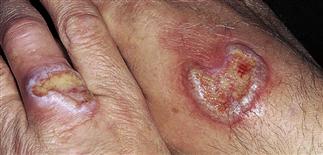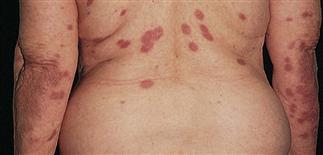91
Sweet syndrome

Plum-colored plaques are sharply demarcated and give a pseudovesicular appearance.

Plaques can ulcerate and be very painful.

Tender plaques that sometimes blister can occur on any skin surface but are more common on the head, neck, and extremities; the torso can be involved in widespread cases.

Multiple red edematous sharply demarcated plaques on the lower extremities.
DESCRIPTION
An acute inflammatory eruption characterized by multiple pink to red tender plaques, associated with fever, malaise, and leukocytosis.
HISTORY
• Occurs in adults of all ages (mean age 56 years); uncommon in children. • Often preceded by an upper respiratory infection. • In 15–20%, Sweet syndrome is paraneoplastic (hematologic malignancy, solid tumors) and may precede the malignancy by up to 6 years. Paraneoplastic Sweet syndrome affects mucous membranes, tends to be recurrent, and occurs more commonly in males. • Other associated conditions include streptococcal infection, inflammatory bowel disease, autoimmune disorders (Hashimoto thyroiditis, Sjögren syndrome), myelodysplastic syndrome, and acute myelomonocytic leukemia. Sweet syndrome has been associated with pregnancy. Systemic symptoms include fever higher than 38°C (50%), malaise, arthralgias or arthritis (62%), eye involvement (conjunctivitis, episcleritis, iridocyclitis) (33%), and oral aphthae (13%). • Can be self-limiting in some patients. A minority of patients (15%) develop relapses for several years.
PHYSICAL FINDINGS
Erythematous, edematous, ‘juicy’ (pseudovesicular), plum-colored papules and plaques erupt acutely, can be painful, and favor the head, neck, legs, arms, dorsal hands, and fingers.
TREATMENT
• Systemic corticosteroids (prednisone 0.5–1.5 mg/kg q.d.) produce rapid improvement and can be tapered over 2–6 weeks. • Minocycline 100 mg b.i.d., or doxycycline 100 mg b.i.d., may be effective. • Oral potassium iodide 15 mg/kg q.d. inhibits neutrophil chemotaxis and equals systemic corticosteroids in effectiveness. • Other therapies include colchicine, dapsone, clofazimine, non-steroidal anti-inflammatory agents, and ciclosporin.







